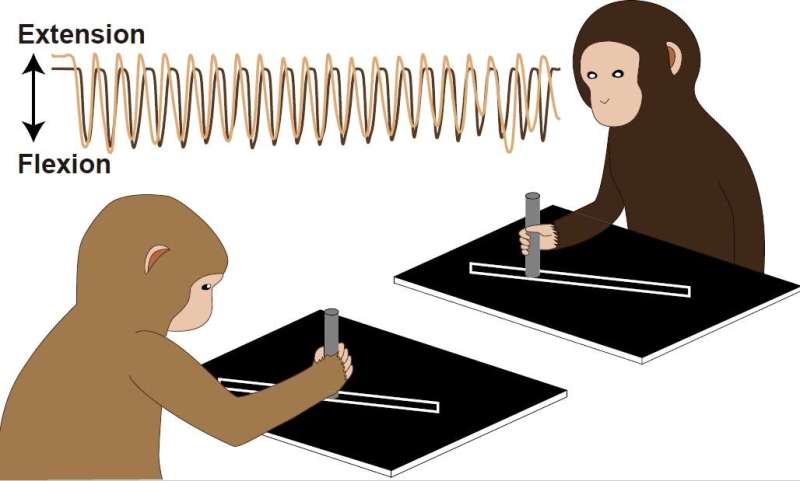This article has been reviewed according to Science X's editorial process and policies. Editors have highlighted the following attributes while ensuring the content's credibility:
fact-checked
peer-reviewed publication
trusted source
proofread
Monkey see, monkey do: Observing macaques to better understand movement synchronization

Humans have long known how to synchronize to rhythms. But now, researchers from Japan have found that movement synchronization spontaneously takes place in macaque monkeys as well. In a study recently published in Proceedings of the National Academy of Sciences (PNAS), a research team led by the National Institute for Physiological Sciences has observed "social motor entrainment," i.e., movement synchronization between individuals, in macaques in a laboratory environment.
Although social motor entrainment has been suggested to reinforce social cohesion, the neural underpinnings of this mechanism are not well understood, which the researchers aimed to address. "Social motor entrainment is robust in humans," says lead author of the study Saeka Tomatsu. "Because synchronized movements encourage social cohesion in humans, they may play an important role in the formation of large social networks among groups."
To investigate the evolutionary origin of social motor entrainment, the researchers examined the way in which macaques synchronized their movements with those of other macaques. They compared synchronization across several types of situations: movements between a pair of real monkeys, the movements of a monkey watching a video of a monkey making the same repetitive movements, and the movements of a monkey watching a video of a horizontal bar sliding in the same direction as the real-life movements.
"The results were surprising," explains Masaki Isoda, senior author. "We found that the macaques exhibited social motor entrainment without prompting by the experimenters." Furthermore, the observed motor entrainment varied according to the animal pairs, social hierarchy, and the type of stimulus.
"The motor entrainment in macaques was facilitated by real-time social exchanges, and was diminished when using videos of macaques making the same movements," explains lead author Saeka Tomatsu. "Therefore, this type of motor entrainment appears to be specific to real-life social interactions."
Creating research settings and tasks that can be used to ethically study behavior is valuable; the framework created and tested in this study could facilitate research about the neurological and evolutionary origins of social behavior in non-human primates. This achievement, together with the verification of the presence of motor entrainment during real-time social exchanges, sets the stage for future research on motor synchrony as a social phenomenon. This could lead to new understanding about human conditions connected to impaired social cohesion, such as autism spectrum disorder.
More information: Saeka Tomatsu et al, Tuning in to real-time social interactions in macaques, Proceedings of the National Academy of Sciences (2023). DOI: 10.1073/pnas.2301614120



















